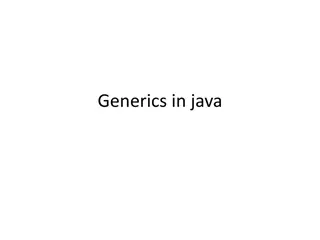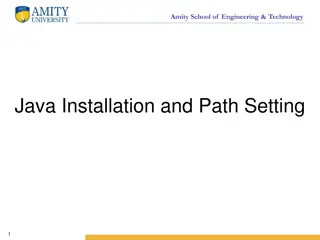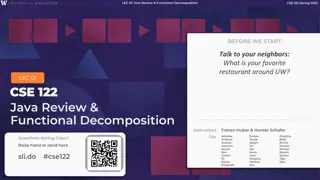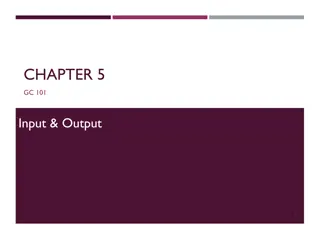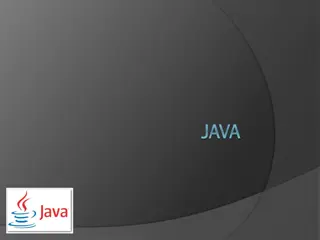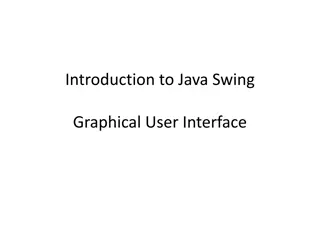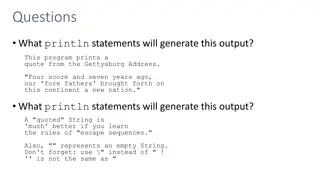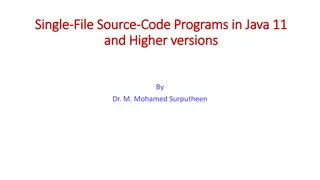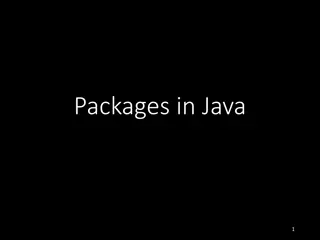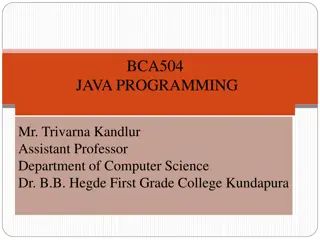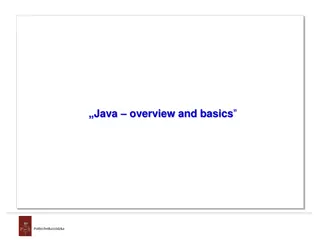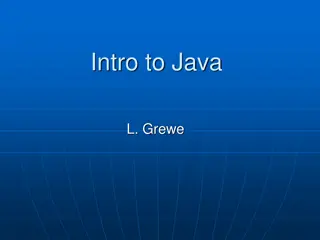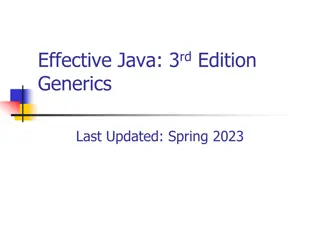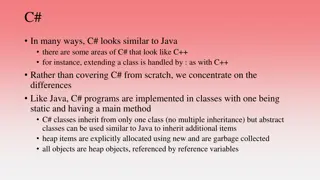Working with System.out.print and System.out.println in Java
Control the output in Java using the System.out.print and System.out.println methods. Understand escape sequences to manipulate the cursor position and format specifiers to enhance output display. Explore example programs demonstrating the usage of these methods and learn about the common syntax employed in Java programming.
Download Presentation

Please find below an Image/Link to download the presentation.
The content on the website is provided AS IS for your information and personal use only. It may not be sold, licensed, or shared on other websites without obtaining consent from the author.If you encounter any issues during the download, it is possible that the publisher has removed the file from their server.
You are allowed to download the files provided on this website for personal or commercial use, subject to the condition that they are used lawfully. All files are the property of their respective owners.
The content on the website is provided AS IS for your information and personal use only. It may not be sold, licensed, or shared on other websites without obtaining consent from the author.
E N D
Presentation Transcript
1. System.out.print 2. System.out.println 3. Escape Sequences 4. System.out.printf 5. Format Specifiers 2
SYNTAX System.out.print (expression); System.out.print (29/4); Example Output Note the cursor position (_): it is on the same line as the output. Note that 29/4 is not enclosed between quotes it is evaluated. 1 7_ SYNTAX System.out.println (expression); System.out.println (29/4); Example Output 1 2 7 _ Note the cursor position (_): it is on the next line to the output. SYNTAX System.out.println (); Skips a line. Output 1 _ 3
PROGRAM 1 PROGRAM 1 1 2 3 4 5 6 7 8 9 // import necessary libraries public class userOutput1 { public static void main (String[] args) { // Declaration section: to declare needed variables // Input section: to enter values of used variables // Processing section: processing statements // Output section: display program output } // end main } // end class 10 11 12 13 14 System.out.print ( Hello there ); System.out.println ( My name is Fatma ); //output line 1 System.out.println ( I am studying Java ); //output line 2 //output line 1 The output of Program 1 is as follows: 1 2 3 Hello thereMy name is Fatma I am studying Java _ 4
ESCAPE SEQUENCES ESCAPE SEQUENCES Escape sequences allow you to control the output. All escape sequences start with a backslash \ character. The following table shows some of the most commonly used escape sequences: Syntax \n \r \t \b \\ \ \ Syntax Escape Sequence New line Return Tab Backspace Backslash Single quote Double quotes Escape Sequence Description Cursor moves to the beginning of the next line. Cursor moves to the start of the current line. Cursor moves to the next tab stop. Cursor moves one space to the left. Backslash is printed. Single quotation is printed. Double quote is printed Description 5
PROGRAM 2 PROGRAM 2 1 2 3 4 5 6 7 8 9 // import necessary libraries public class userOutput2 { public static void main (String[] args) { // Declaration section: to declare needed variables // Input section: to enter values of used variables // Processing section: processing statements // Output section: display program output } // end main } // end class 10 11 12 13 14 System.out.print ( Hello there \t ); System.out.print ( My name is Fatma\n ); //output line 1 System.out.println ( I am studying \ Java\ );//output line 2 //output line 1 The output of Program 2 is as follows: 1 2 3 Hello there I am studying Java _ My name is Fatma 6
SYNTAX System.out.printf (formatString); System.out.printf ( Hello there!! ); Example 1 Output 1 Hello there!!_ SYNTAX System.out.printf (formatString, argumentList); The argumentList is a list of one or more arguments: constant values, variables, or expressions. If the argumentList has more than one argument, then the arguments are separated by commas. 7
FORMATTING FORMATTING INTEGER INTEGER NUMBERS NUMBERS int x = 120; System.out.printf ( The value of x = %d , x); The value of x = %d is the formatString. x is the argumentList. %d is called a format specifier. There is one-to-one correspondence between the format specifier and the arguments in the argumentList. The format specifier used depends on the type of the argument. %d is used for the variables of type int. Example 1 Output 1 The value of x = 120_ int cm = 25; int mm = 2500; System.out.printf ( There are %d mm in %d cm , mm, cm); The formatString is There are %d mm in %d cm . The argumentList is mm, cm Example 2 Output 1 There are 2500 mm in 25 cm_ 8
FORMATTING FORMATTING FLOATING FLOATING- -POINT POINT NUMBERS NUMBERS The default output of floating-point numbers is: o up to 6 decimal places for float values, and o up to 15 decimal places for double values. The %f is the format specifier used for floating-point numbers. %.2f specifies the number of digits printed after the decimal point (2 in this example). static final float PI = 3.14159f f; double radius = 7.534; System.out.printf ( PI = %.3f and radius = %.1f , PI, radius); Example 1 Output Note that the numbers are approximated. 1 PI = 3.142 and radius = 7.5_ double area = 227.534; System.out.printf ( Area = %8.2f , area); Example 2 Output 1 Area = ~~227.53_ 9
FORMATTING FORMATTING CHARACTER CHARACTER VARIABLES VARIABLES The %c is the format specifier used for char values. char option = Y ; System.out.printf ( Option = %c , option); Example Output The following are other format specifiers: Specifier %d %f %c %s %e %n %% 1 Option = Y_ Specifier Description The result is formatted as a (decimal) integer The result is formatted as a decimal floating-number The result is a Unicode character The result is a string The result is formatted as a scientific notation Line separator Prints % Description 10
NOTES NOTES By default, the output is right-justified for all primitive data types. String name = aly ; System.out.printf ( First name = %6s%n , name); Example 1 Output 1 2 First name = ~~~aly _ To print it left-justified, precede the width with a sign: String name = aly ; System.out.printf ( First name = %-6s%n , name); Example 2 Output 1 2 First name = aly~~~ _ int year = 2015; System.out.printf ( Academic year = %-6d-%6d , year, ++year); Example 3 Output 1 Academic year = 2015~~-~~2016_ 11
What is the output of the following program: 1 2 3 4 5 6 7 8 9 public class selfCheck1 { public static void main (String[] args) { int num = 52033; double x = 9234.8667; String str = Computer Science ; System.out.printf ( %-5d%-10.2f%-20s ***%n , num, x, str); System.out.printf ( %-25s%-6d%-12.3f ***%n , str, num, x); System.out.printf ( %-13.4f%-7d%-22s ***%n , x, num, str); } // end main } // end class 10 11 12 W3.3 Output Statements 12
A milk carton can hold 3.78 liters of milk. Each morning, a dairy farm ships cartons of milk to a local grocery store. The cost of producing one liter of milk is $0.38, and the profit of each carton of milk is $0.27. Write a program that does the following: Prompts the user to enter the total amount of milk produced in the morning. Outputs the number of milk cartons needed to hold milk (Round your answer to the nearest integer). Outputs the cost of producing milk. Output the profit for producing milk. W3.3 Output Statements 13



